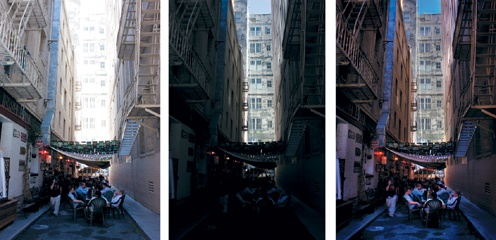A Word About Dynamic Range
There is a range from very dark to very bright wherein your eyes can see detail. Below this range, things are too dark, and above this range, things are painfully bright. This is called dynamic range, and in humans, it's about 18 stops wide. That is, there are about 18 doublings of light from darkest to lightest.
Unfortunately, like all cameras, the Rebel XS has a much smaller dynamic range than what the human eye can perceive. About half the range, actually. This means that, with a single shot, you cannot capture some scenes in the way your eye sees them. For example:

Figure 7-36. The image on the right has such a huge dynamic range that it couldn't be captured in one shot. Instead, I had to shoot an image exposed for the shadows and one exposed for the highlights and then combine them in an image editor.
This image has a very large dynamic range. There are details in the shadows and details in the highlights. It was not actually possible to capture this in one shot. Instead, I had to take two shots, one exposed for shadows and the other exposed for highlights, and then combine them in an image editor. Unfortunately, performing this kind of combining is not always possible, either because your subject is moving, you didn't think to take multiple shots, or the postproduction work is too hard. Most of the time, when shooting a scene like this, you simply have ...
Get The Canon EOS Digital Rebel XS/1000D Companion now with the O’Reilly learning platform.
O’Reilly members experience books, live events, courses curated by job role, and more from O’Reilly and nearly 200 top publishers.

